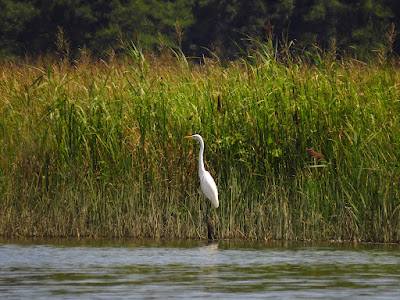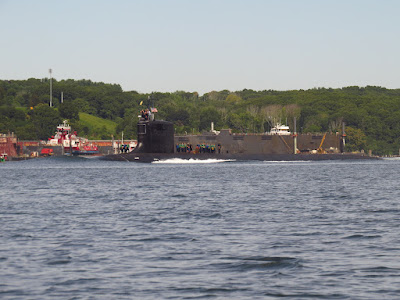We put in on the North Cove in Essex. I don't think M has ever started here before, although we have started from Ely Ferry on the far side of the river. It is a beautiful Sunday with moderate temperatures, a light wind, and an overcast that is soothing and keeping the sun off, at least for awhile. We head out through the breach and straight across the river. There is little traffic in sight, so far.
As we reached the opposite shore, the number of bird sightings increased. It was mostly Great Egrets and Osprey with many Cormorants and a few Great Blue Herons. All fish eaters, there is no doubt, there are a lot of menhaden and minnows in the river. M was impressed with the count. I mentioned that this is the fattening up season before migration. We headed down river.
I packed my tracking kit - plaster, a mixing bowl and some plastic strips to build a wall around an animal track. There is a good amount of exposed sand beach in this section, but the tide was just high enough to submerge most of it. When we spotted some tracks and went over to look, it was human and dog footprints - some boater giving their dog a break, not interesting enough to cast. |
As we neared the entrance to Lord Cove, we lost the protection of Nott Island and began to get bounced by wakes from speeding boats on their way to twofer Bloody Mary's, or some such nonsense. It didn't last long and we turned into the backwaters of the cove.
On my last trip here, the Osprey were concentrated on the main river. There were big schools of menhaden in the main river on that day. Today, I'd guess that we're seeing the same number of birds, but they are wider dispersed - less on the main river, but more in the cove.
We paddle across Goose Bay and head up into the farther reaches of Lord Cove. The Osprey and Great Egret sightings are frequent.
We pause for a minute or two at the small bridge...in the Bridge Inlet (my name), for three horse back riders to pass. The horses were definitely unsure about seeing a canoe below them. We do a quick check on the wild rice - no where near ready for harvest. Then we head out and up deeper into the cove to check on the Eagle nest. I didn't expect to see any Eagles on the nest, and they weren't. With that, we were 2-1/2 hours out and it was time to start moving in the return direction.
We pass a couple fishing for crab from a small outboard. M asks what they'll make with the catch...pasta dishes of some sort that i don't remember. Anyway, they are the first people that we've seen since leaving the main river. Today, it is very quiet back here. As we reach Goose Bay, M spots a large mature Bald Eagle. It might be the female from the nest we were looking at. I've seen her before, and she is very large (female Eagles are larger than the males). Back at Goose Bay, a flock of ten Mute Swans has moved in. M spots a large mature Bald Eagle
Back on the main river, we get bounced again by wakes. It's afternoon now and the sleepy heads of gotten out on the water with the big motors. While we were in the cove, I considered crossing the river and returning on the far shore, but this is area has fast boats and far too many of them, so we head back up behind Nott Island. We cross at the top of Nott Island, and although there is a lot of traffic, this is a slow speed zone and we make the crossing without any issues.
M comments that she doesn't want to anthropomorphize the birds, but they look happy. A good observation, we talk about how active they are and that they may not be happy, but they are busy with lots of easy food to hunt and eat..and that would look to us like, "happy."
A fine day...just what the doctor ordered









































